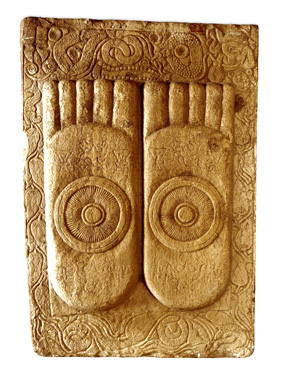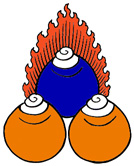| |

Studies
in
Buddhadharma
On Buddha Śâkyamuni
 Contents
Contents  SiteMap
SiteMap

"All compounded things are
ephemeral.
Work diligently on your salvation."
Buddha's last words
|
|

Amaravati Stupa - India
1st century BCE -
limestone (BM) |
|
|
In the early, aniconic stage
of Buddhist Art, the Buddha was represented by his footprints ("Buddhapâda"). These imprints are venerated in all Buddhist countries.
Feet, symbolizing the Earth, or the grounding (manifestation) of the Divine, have been
objects of respect in India long before Buddhism. According to
legend, after the Buddha attained enlightenment, his feet
made imprints in the stone where he stepped.
These footprints symbolize the presence of the Buddha. After his final
enlightenment ("parinirvâna"), they signify his absence.
Usually, these footprints were depicted with toes of equal
length and a wheel ("dharmacakra") in the center. Other early
Buddhist symbols also appear on the heels and toes, such as the
Lotus, the Swastika and the Three Jewels or Triple Gem ("triratna"). Some can be
large and detailed, displaying the 32, 108 or 132 distinctive marks
of a Buddha. |
About 2500 years ago,
Siddhârtha Gautama (ca. 563 - 483 BCE) was born to a life of privilege &
wealth in a town called Lumbinî, near Kapilavastu, just inside the borders
of Nepal. This was the home of the capable Śâkya clan and Siddhârtha ("one
who has accomplished his goal"), as he was probably called, was the son of Śuddhodana, a warrior of
wealth and power, and Mâyâdevî, a woman of refinement. Alternative
research suggests he was born ca. 450 or ca. 485 BCE. In 2013, at one of
Buddhism's most revered pilgrimage sites at Lumbinî (the Mâyâ Devî Temple) an excavation
revealed a previously unknown timber shrine, evidencing Buddha lived in
the sixth century BCE. But scholars like Gombrich dismisses the evidence
as "self-serving hype, more worthy of a politician than of an academic"
(Website of the Journal of the Oxford Centre for Buddhist Studies,
december 2013). We know emperor Aśoka sent various missionaries abroad. In
the Southern (Singhalese) tradition Aśoka came to the throne 218 years
after Buddha's death. Correlating this ascension with Hellenistic rulers
puts it at 268 BCE, giving 486 BCE for the death of the Buddha. But some
(like Gombrich) place Aśoka's ascension 136 years after Buddha's death ...
Scholars tend to place the death of the Buddha nearer to 400 than 500 BCE.
The truth is, we do not know.
At the time of his birth, among the foothills of the Himalayas, there were
clan-based republics resisting the expansion of the new monarchies of the
central Ganges basin. Most likely, the traditional brahmanical society had
not yet made any great impact upon this region. The republic of the Śâkyas
was ruled by Śuddhodana, belonging to the ruling oligarchy and a member of
the Ksatriya or warrior-nobility caste, the second of the four Indian
castes. Later traditions dubbed Siddhârtha a "prince" and his father a
"king".
From all various sources dealing with the founder of the "śâsana" or
dispensation of the
Buddhadharma, a
central core dawns, detailing important events in the life of Siddhârtha
Gautama the Buddha, or Buddha Śâkyamuni, at least as perceived by his
disciples, for -like most spiritual founders- he left no autobiography,
nor did he write down any of his thoughts ...
Short Biography of Siddhârtha Gautama
the Buddha
The short story-line of Buddha's biography served as the archetypal model for
Buddhists over the centuries and can be summarized as follows (cf. the
Buddhacarita, postdating the Buddha by 500 years !) :
-
563 - 533
BCE : early life : as a "prince", Gautama had three palaces, one for each of season. His life was luxurious and his father, wishing him to
become a worldly ruler instead of a spiritual master, surrounded him
with every possible pleasure. Although elegant & refined, Gautama found
his homes crowded and dusty. When his son, Râhula, or "fetter" was born,
he felt no pleasure and yearned for an "open" existence ;
-
533 BCE
: after witnessing the Four Signs (a sick person, an
old person, a dead person and a religious mendicant), Gautama decided to
leave his family to find a spiritual solution to the problems of the human
condition, in particular rebirth. At 29, taking a last look at his
sleeping wife & child, he departed to become an ascetic of the Śramana
Movement,
wandering renunciants
adopting a path alternate to Vedic rituals :
- they denied an omnipotent Creator-God ;
- rejected the Vedas as revealed texts ;
- believed in "karma", "samsâra" and rebirth of the soul ;
- believed in purification of the soul to attain enlightenment ;
- sought liberation by non-violence, renunciation & austerities ;
- denied the efficacy of sacrifices and rituals of purification ;
- rejected the caste system.
533
- 528 BCE : to enlightenment
: the first teacher he took was Âlâra Kâlâma. Soon he
mastered his teaching, entering the four levels of concentration on form ("dhyânas")
one after the other. Offering him joint leadership, Gautama refused
because, although blissful and serene, one eventually exited these
concentrations on form and returned to the fundamental problems of waking
consciousness : birth, sickness, old age and death. Then he found Uddaka
Râmaputta, who had mastered the four formless ("ârûpya") absorptions
("samâpattis").
But the fourth, or most sublime state of mind possible in the formless
realm, was again not the goal he sought. Râmaputta wished to become his
disciple, but Gautama refused. Next, he turned to austerities, aimed to subdue
the desire nature. Neither did these self-mortifications produce the
result he was seeking ! Emaciated, his hair began to fall out. He was
unable to sit upright. After six years of hard austerities, he spontaneously
realized extremes of any kind were unproductive. When the cord of the bow
is too stretched it may snap, when it is too loose, one cannot play it.
Moreover, only one criterion should persist, namely direct personal
knowledge (hearsay, tradition, intellectual speculation & the ways of
honourable ascetics are rejected). So "Know for Yourselves !" sums it up.
This measured asceticism was designated as "the Middle Path" ;
April/May 528 BCE :
enlightenment :
in the course of a single night, seated beneath a large tree,
later kown as the Bodhi tree (Ficus Religiosus), Gautama attained a
complete state of awakening or enlightenment and was henceforth called
"the Buddha" (the awakened one). He acquired the power to remember all his
previous lives, became clairvoyant, knew he had rooted out ignorance,
clinging & aversion once and for all and put an end to his own rebirth.
Staying at Bodh Gayâ for seven weeks, Buddha Śâkyamuni pondered his future.
Considering humanity too gross to benefit from his teachings, he decided
to remain silent about his profound realization. Only after the "pure
ones", like Brahmâ Sahampati & Indra, came down from the highest planes of
existence begging him to teach the Dharma, did the Buddha decide to help
and teach
those with only "little dust in their eyes" ;
528 - 483 BCE : the
First
Turning of the Wheel of Dharma
: arriving in the royal deer park near Vârânasî, he was welcomed by
the group of five ascetics who had earlier turned their backs on him for
rejecting the path of austerities. He proclaimed himself a "Tathâgata", a
word etymologically meaning "a speaker of the Truth", but also "one who
has attained what is really so" or "one who is thus gone" (remarkably,
"tathâ âgata" means "one who is thus come") and gave his First Sermon,
called "Setting in Motion the Wheel of the Dharma".
The Mahâyâna Mind-Only School introduced the pedagogic scheme of the
"Three Turnings". When Buddhist Tantra became academic (in the 7th century
CE), a "Fourth Turning" was added ... These Turnings organized the various
teachings, some of which were considered "definitive" and others
"provisional". The latter implies the style of explanation shows
its meaning indirectly, aiming to guide someone gradually (like a
finger pointing at the Moon). The former shows the meaning directly
(like immediately revealing the Moon itself).
The different "Turnings" are said to
represent various levels of the teachings, and therefore call for
different audiences. Together, they constitute the "84.000 Dharma Doors".
1) The First Turning contained the essential teachings : the
Four Noble Truths, the
Eightfold Path
& the Two Truths,
acting as the
foundation for the entire Buddhadharma : the
Hînayâna (Tripitaka),
the
Sûtras & the
Tantras. All five became his disciples and
soon realized
enlightenment. A large number of people realized the same and the
teachings spread. An order of monks and one for nuns was established.
Travelling on foot through the town and villages of North-East India (an
area somewhat smaller than Ireland), the Buddha addressed a variety of audiences
and gave teachings adapted to each of them. Because in this Turning
reality is not yet analyzed and its samsaric substance-nature taken for
granted, all schools accept these teachings as provisional.
2) The Second Turning is said to have taken place at Vulture Peak Mountain in
Râjagriha, Bihar. It focused on
compassion ("karunâ") &
emptiness ("śûnyâta"). Compassion is the
primary constituent of the "mind of enlightenment" ("Bodhicitta"),
essential to the
Mahâyâna, and a preliminary to the
understanding of emptiness.
In the Middle Way Consequence School (Nâgârjuna, Âryadeva, Chandrakîrti,
Shantideva, Tsongkhapa), the Second Turning is deemed "definitive".
3) The Third Turning, in Kuśinagarâ, had our
Buddha-nature as object (the "Tathâgatagarbha" doctrine).
In the Great Middle Way (Other Emptiness or "zhentong", commonly
spelled "shentong", accepted by Nyingmapas, Kagyus & Jonangpas), the Third Turning
is considered "ultimate definitive" and the Second Turning
"non-ultimate definitive", whereas in the view of the Consequentialists
(all Gelugpas & most Sakyapas), the Third Turning is provisional.
The view expressed in this Turning is also found in Ch'an Buddhism (later Zen), Mahâmudrâ &
Mahâsandhi (Dzogchen).
4) Lastly, in the
Fourth Turning, Buddha explained the
Tantric teachings, crucial to the
Vajrayâna. This Turning is said to have
occurred on the
subtle planes
of reality, with Buddha appearing to superior meditators as
Vajradhâra. This last turning is not accepted by those refusing to
incorporate the special methods of Tantra into the Buddhadharma.
It should be remarked the oldest texts, the
Pâli Canon, mostly
cover the contents of the First Turning, but also refers to the Second
Turning. The "tathâgatagarbha" thematizes the innately pure luminous mind
("prabhâsvara-citta")
briefly mentioned in the
Anguttara Nikâya,
I.10 (49/9). Tantric Buddhism, with is secret and esoteric doctrines, is
however absent in the early texts ...
"I have taught the Dharma Ânanda, making no 'inner'
and 'outer' : the Tathâgata has no 'teacher's fist' in respect to
doctrines." (Digha
Nikaya, II. 100.)
483 BCE : physical death
: when he
was 80 and in failing health, the Buddha continued his travels on foot,
eliminating the effects of his infirmity with his mental powers. He did
not appoint a successor, for none was needed. After his physical demise, the
Dharma would be the
only guide. On matters of doctrine, so he told his disciples, each
person should make up his or her own mind, cross-referencing views and
opinions against the teachings. In Kuśinagarâ, lying on his right side
between two Sal trees, the physical body of the Buddha died. His last
words were : "All compounded things are ephemeral.
Work diligently on your salvation." ;
483 BCE : final
enlightenment
:
dying serene and self-composed, the Buddha passed through several levels
of meditative absorption, entering "parinirvâna", often equated with the
state of "nirvâna" after physical death. Entering this state did
not annihilate him, nor did it sustain him. The "Dharmakâya" is beyond
conceptual affirmation & denial. The Buddha is the First Jewel of the
Triple Gem.

|
|




